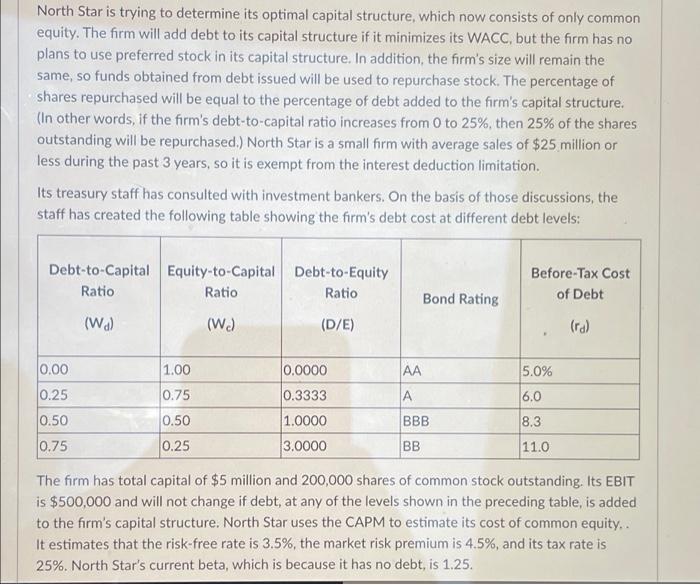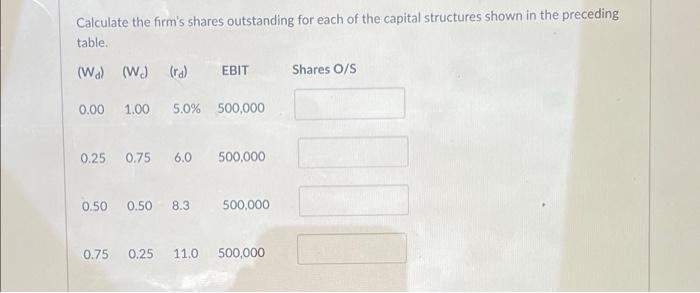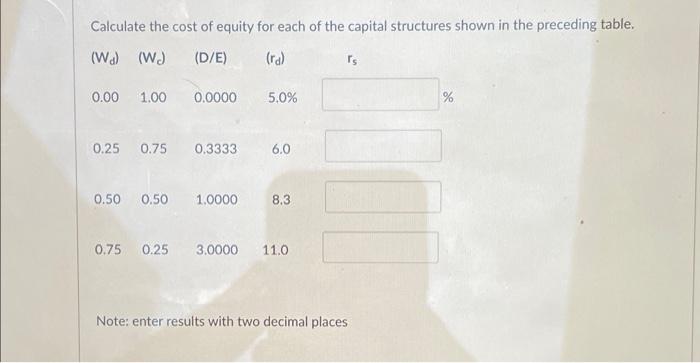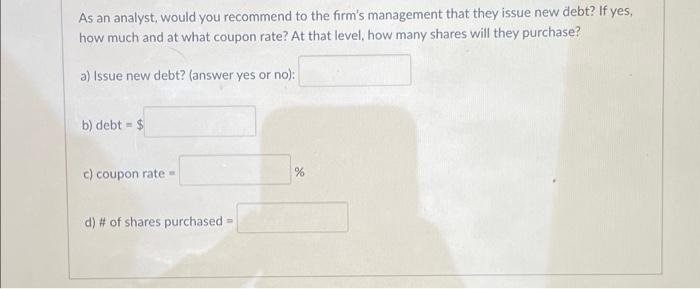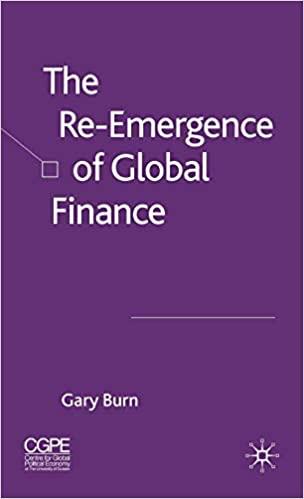North Star is trying to determine its optimal capital structure, which now consists of only common equity. The firm will add debt to its capital structure if it minimizes its WACC, but the firm has no plans to use preferred stock in its capital structure. In addition, the firm's size will remain the same, so funds obtained from debt issued will be used to repurchase stock. The percentage of shares repurchased will be equal to the percentage of debt added to the firm's capital structure. (In other words, if the firm's debt-to-capital ratio increases from 0 to 25%, then 25% of the shares outstanding will be repurchased.) North Star is a small firm with average sales of $25 million or less during the past 3 years, so it is exempt from the interest deduction limitation. Its treasury staff has consulted with investment bankers. On the basis of those discussions, the staff has created the following table showing the firm's debt cost at different debt levels: Debt-to-Equity Debt-to-Capital Ratio Equity-to-Capital Ratio Before-Tax Cost of Debt Ratio Bond Rating (Wa) (W) (D/E) (ra) 0.00 1.00 0.0000 AA 5.0% 0.25 0.75 0.3333 A 6.0 0.50 0.50 1.0000 BBB 8.3 0.75 0.25 3.0000 BB 11.0 The firm has total capital of $5 million and 200,000 shares of common stock outstanding. Its EBIT is $500,000 and will not change if debt, at any of the levels shown in the preceding table, is added to the firm's capital structure. North Star uses the CAPM to estimate its cost of common equity.. It estimates that the risk-free rate is 3.5%, the market risk premium is 4.5%, and its tax rate is 25%. North Star's current beta, which is because it has no debt, is 1.25. Calculate the firm's shares outstanding for each of the capital structures shown in the preceding table. (Wa) (W) (ra) EBIT Shares O/S 0.00 1.00 5.0% 500,000 0.25 0.75 6.0 500,000 0.50 0.50 8.3 500,000 0.75 0.25 11.0 500,000 Calculate the cost of equity for each of the capital structures shown in the preceding table. (W) (W) (D/E) (ra) 0.00 1.00 0.0000 5.0% % 0.25 0.75 0.3333 6.0 0.50 0.50 1.0000 8.3 0.75 0.25 3.0000 11.0 Note: enter results with two decimal places. At what capital structure does the firm maximize shareholder value? Is this the same capital structure selected in #10 and #15? a) The capital structure at which the firm's value is maximized is debt = % and equity= % b) Is this the same capital structure selected in # 10 and #15? (answer yes or no): As an analyst, would you recommend to the firm's management that they issue new debt? If yes, how much and at what coupon rate? At that level, how many shares will they purchase? a) Issue new debt? (answer yes or no): b) debt = $ c) coupon rate= % d) # of shares purchased F North Star is trying to determine its optimal capital structure, which now consists of only common equity. The firm will add debt to its capital structure if it minimizes its WACC, but the firm has no plans to use preferred stock in its capital structure. In addition, the firm's size will remain the same, so funds obtained from debt issued will be used to repurchase stock. The percentage of shares repurchased will be equal to the percentage of debt added to the firm's capital structure. (In other words, if the firm's debt-to-capital ratio increases from 0 to 25%, then 25% of the shares outstanding will be repurchased.) North Star is a small firm with average sales of $25 million or less during the past 3 years, so it is exempt from the interest deduction limitation. Its treasury staff has consulted with investment bankers. On the basis of those discussions, the staff has created the following table showing the firm's debt cost at different debt levels: Debt-to-Equity Debt-to-Capital Ratio Equity-to-Capital Ratio Before-Tax Cost of Debt Ratio Bond Rating (Wa) (W) (D/E) (ra) 0.00 1.00 0.0000 AA 5.0% 0.25 0.75 0.3333 A 6.0 0.50 0.50 1.0000 BBB 8.3 0.75 0.25 3.0000 BB 11.0 The firm has total capital of $5 million and 200,000 shares of common stock outstanding. Its EBIT is $500,000 and will not change if debt, at any of the levels shown in the preceding table, is added to the firm's capital structure. North Star uses the CAPM to estimate its cost of common equity.. It estimates that the risk-free rate is 3.5%, the market risk premium is 4.5%, and its tax rate is 25%. North Star's current beta, which is because it has no debt, is 1.25. Calculate the firm's shares outstanding for each of the capital structures shown in the preceding table. (Wa) (W) (ra) EBIT Shares O/S 0.00 1.00 5.0% 500,000 0.25 0.75 6.0 500,000 0.50 0.50 8.3 500,000 0.75 0.25 11.0 500,000 Calculate the cost of equity for each of the capital structures shown in the preceding table. (W) (W) (D/E) (ra) 0.00 1.00 0.0000 5.0% % 0.25 0.75 0.3333 6.0 0.50 0.50 1.0000 8.3 0.75 0.25 3.0000 11.0 Note: enter results with two decimal places. At what capital structure does the firm maximize shareholder value? Is this the same capital structure selected in #10 and #15? a) The capital structure at which the firm's value is maximized is debt = % and equity= % b) Is this the same capital structure selected in # 10 and #15? (answer yes or no): As an analyst, would you recommend to the firm's management that they issue new debt? If yes, how much and at what coupon rate? At that level, how many shares will they purchase? a) Issue new debt? (answer yes or no): b) debt = $ c) coupon rate= % d) # of shares purchased F
